|
[Front Page] [Features] [Departments] [Society Home] [Subscribe]

Electronic Mailbox
 
The following have been selected from the questions received on the ASGAP World Wide web site over the past few months. You're welcome to comment on any issue concerning Australian native plants....growing, propagating or appreciating (even loathing!) ... anything.
If necessary, bung a message in a bottle if your net connection goes down!!
....and, if you'd like to contact any of the correspondents and no email address is listed, please feel free to do so through the editor.

Trees for Privacy
I am trying to get recommendations for a native tree to plant in my backyard which will give some privacy and may possibly attract birds. We live in the Eastern Suburbs of Sydney and want to grow a tree to screen some houses about 20 metres away. There are no overhead power lines , but I am looking for a medium size tree anyway, eg. I was thinking a bottlebrush might be appropriate.
Thanks
Chris
Sydney
If you mean something to about 5-6 metres, the weeping bottlebrush (Callistemon viminalis) would be good - attracts birds as well. The cultivar "Hannah Ray" is a good form.
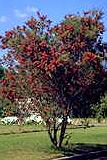 |
Callistemon viminalis, weeping bottlebrush, is an attractive small tree suited to many soils and climates.
Select the thumbnail image or highlighted name for a higher resolution image (43k).
|
Other possibilities are:
- Some of the larger grevilleas - "Honey Gem", "Moonlight", "Misty Pink" etc. All quick growing and suited to Sydney.
- Banksias - B.ericifolia and B."Giant Candles" should do well in your area and are good screening plants. B.integrifolia (Coast Banksia) is a bit bigger but is also excellent. All banksias are bird attracting.
- Melaleuca nesophila does well in Sydney despite its Western Australian origin and is an attractive, quick growing small tree - again bird attracting.
- Smaller eucalypts would also be worth considering. Eucalyptus leucoxylon "Rosea' is a good one with red flowers (usually).
Probably the best thing would be to visit a specialist native plant nursery and get some first-hand advice. There are lots of nurseries listed here
 |
|
Colourful and reliable plants for screening...bird attracting too!!
Melaleuca nesophila (top), quick growing and should flower in its third year from seed.
Grevillea "Honey Gem" (centre), flowers for 12 months of the year in warm climates.
Eucalyptus leucoxylon "Rosea" (bottom), with flowers usually from pink to deep red.
Select the thumbnail image or highlighted name for a higher resolution image (39k, 29k and 31k).
|
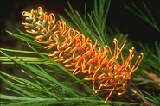 |
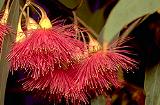 |

Eucalypts and Bushfires
I love your society's page, it's very nice, but I need some more information on eucalypts and brushfires.
We were having a discussion and one person said that "eucalyptus trees must have fire to drop their seeds and then the tree explodes into flames because of its oil content". I don't entirely accept this statement and thought that they were actually resistant to brushfire and the seeds were dropped when exposed to heat.
While we were in New South Wales walking around it seemed that the trees' bark was blackened but they were very much alive and in full leaf. Please let me know a little more about these remarkable trees of Australia.
Thank you very much,
Rebecca
USA
Thanks for your message.....glad you like the web site.
There's no easy answer to your question and I'm no expert on eucalypt morphology but the following is probably a reasonable simplification.
Firstly, eucalypts do have a considerable oil content in their leaves and they do burn intensely in bushfires because of this. Eucalypts have developed a range of mechanisms to cope with fire and regeneration. Some species can use a number of methods while others are more specialised. Some species retain the seed in closed capsules in the tree canopy more or less indefinitely while others will release seed more frequently.
There are some species that are killed outright in severe fires and can regenerate only by seed. In these cases, seed capsules which escape destruction by fire open to release the seeds sometime after the fire has passed. The seeds fall onto the cooled ash bed and germinate quickly. Species that rely only on seed for regeneration require a number of years without fire so that the new trees can reach maturity, flower and set seed. Too frequent fires can eliminate these species from a particular ecosystem. An example of a species in this category is Eucalyptus regnans, the Mountain Ash.
Many other eucalypts have what is known as a lignotuber - a woody swelling at or below ground where regenerative buds can develop if the above ground part of the tree is destroyed by fire. These species tend to be those in the more fire-prone habitats. They are less dependent on seed for regeneration and, in fact, many of the lower growing species would lose much of their stored seed in a severe fire. A group in this category are the mallees which are common in dry parts of Australia. These can have very large underground lignotubers with masses of thin stems arising from them.
A third method is regeneration by epicormic shoots. This is a similar method to the above but the regenerative buds are below the bark in the trunk and branches. The bark protects the buds from the fire and, a week or two after the fire passes, the new shoots will be seen emerging from the blackened trunks.
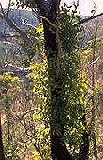 |
Epicormic shoots form lush growth on this eucalypt in the Blue Mountains of New South Wales.
Select the thumbnail image or highlighted name for a higher resolution image (38k).
|
Let me know if there is anything that needs further clarification.

Fire Resistant Native Plants
I am visiting Australia from southern Spain where we have a grave, increasing problem of fire hazard through arson. I am anxious to locate and meet with any nursery or grower or seed merchant who deals with Australian native, fire resistant or fire retardant plants, especially ground cover, shrubs and vines, with a view to setting up an arrangement to import same to Europe.
We have several native specimens but am told you have many more here and would like to compare.
Gill Scott
Spain
I don't know of any nursery or seed merchant that deals specifically in fire retardant plants.
However, there are several listings of potentially suitable species on the web so the best I can do is suggest you take a look at these lists and then contact seed merchants listed on our seed suppliers page.
I think you will need to concentrate on seed rather than plants as I'm not aware of any Australian native plant nursery that exports these types of plants.

Australian Plants and pH
I was wondering if you could help me.
I would like to know the pH range for Australian Natives such as banksias and acacias which would not inhibit the trees growth. Not necessarily the ideal pH levels, just the range that they survive in.
Regards
Gloria El-Bacha
It's not really possible to generalise and say that Australian native plants prefer a particular pH range because Australian soils cover a range of pH from alkaline to acidic and native plants have evolved to cope with those soil conditions.
Having said that, it's probably true to say that most of the native plants that are available in nurseries are those that prefer soil pH to be slightly acid. You will probably find that pH between about 6 and 6.5 would suit most of these.

Removal of Pittosporum
I live in Melbourne and am hoping you can help me with a question about Pittosporum undulatum.
I had never taken much notice of the trees in my garden until I realised that there were these ones that seem to be taking over the entire garden and pushing out all the others. When I investigated I found that they were the above mentioned tree. I have started to cut some of them down and am wondering how I can stop them regrowing, as they seem to sprout very quickly from the left over trunk.
Any advice would be much appreciated.
Caroline Wheeler
Melbourne
Pittosporum undulatum has become a problem plant in many areas - even, as in the Sydney Region, in areas where it grows naturally! It seems to be favoured by changes in water runoff patterns caused by urbanisation so it is a real problem in some of the natural areas around Sydney where it out competes and replaces other vegetation, particularly in moist sheltered areas.
 |
The fragrant white flowers and glossy green foliage make Pittosporum undulatum an attractive garden plant....but it is an environmental weed in a number of areas.
Select the thumbnail image or highlighted name for a higher resolution image (36k).
|
To the best of my knowledge, the tree doesn't sucker from the root system so, if the particular specimens are not too large it may be possible kill it by grubbing out the main stem. If this is not possible chemical treatment of the shoots will be needed.
Application of Glyphosate to actively growing shoots should work but the plant is unlikely to be killed with a single application. You will need to be religious in treating regrowth as it occurs - eventually you will win!
Remember too that Glyphosate rarely shows any immediate effect after application - it may be 1-2 weeks before you notice any yellowing of the treated foliage.
You might find the Fact Sheet T47 on "Killing Suburban Trees" (published by the Queensland Department of Natural Resources) useful. You'll find it on the Department's web site along with lots of other useful information.

Alkaline banksias?

|
|
I would like to know if Banksia prionotes and Banksia speciosa are suitable for cultivation in clay/alkaline soil.
Select the thumbnail image or highlighted name for a higher resolution image (37k).
|
Luca De Vincenzi
Italy
Both of these species grow in deep sand in areas of low summer rainfall. They may succeed in heavier soils if they are well drained and in a suitable climate but I would expect that acid soils would be preferred.
I have no personal experience with either species as they are not suited to my local climate.

Red Gum and Honey
In Morocco there is a gum tree that saved its life by ''bleeding'' red sap when the construction team began to chop it down! For real - the building was redesigned in an L-shape to accommodate this phenomenon. Was it a so-called ''Red Gum" ? Which species do this?
Lucille Sabky
New York, USA
 |
|
Well, in fact lots of eucalypts "bleed" a red sap or gum-like substance called "kino" which exudes from the trunk usually after some damage caused by insects or humans.
The term "red gum" doesn't have anything to do with this phenomenon - it refers to the colour of the timber.
|
|
Select the thumbnail image or highlighted name for a higher resolution image (34k).
|

Looking for Rainforest Plants
I'm looking for some help. I'm fairly new to Australia, from Chicago, and am an avid gardener. I Live in Brisbane and want to create a small rainforest garden in our suburban back yard. Searching the net I came across the Australian Plants online site hoping to get some ideas. I was hoping to find names and pix of some common Australian native rainforest plants that would suit a smaller garden, can you help? Any suggestions on where to look for info or suggestions of what plants to look for would be greatly appreciated.
Cindy Grice
Brisbane
 
There are a number of books that would be worth looking at including "Australian Rainforest Plants" by Nan and Hugh Nicholson. There are 4 volumes in this excellent series of booklets - they include good colour photographs and cultivation information and at about $15 each are excellent value. Another good one is "Creating an Australian Rainforest Garden" by Ralph Bailey and Julie Lake, although it's possibly out of print now.
A web site that might help is the one maintained by the Brisbane Rainforest Action and Information Network or "BRAIN".
BRAIN was established in 1995 as a bushcare group sponsored by the Brisbane City Council in Queensland, Australia. The focus of the group is active rainforest regeneration and rehabilitation at a number of sites around Brisbane rather than promoting cultivation of rainforest plants. However, it has photos, identification tips and a database of rainforest species native to the Brisbane area so it should be useful for finding out a bit more about plants suited to the Brisbane area.
Another very useful resource is Fact Sheet T28, "Establishing a Rainforest Garden", published by the Queensland Department of Natural Resources.
You will also find a good list of native plant nurseries in Queensland on the SGAP (Queensland) web site.

Georgina gidyea
I am hoping that you can help me. I need information on the Georgina Gidyea tree particularly its toxic qualities, control, and grazing management.
Any news would be helpful.
Nick Hutley
UK
Searching around the web didn't produce much - the only info I could find was from the "Woody Weeds in Central Australia" site.....
- "Georgina gidyea (Acacia georginae) - Juvenile gidyea has been known to form dense thickets associated with mature plants. Under certain circumstances it can be extremely poisonous to cattle and has caused large losses. Believed to be susceptible to fire, but lack of adequate fuel makes the use of fire less likely."
The "Encyclopaedia of Australian Plants", Vol 2 says...."Leaves and flowers have a strong disagreeable odour especially during moist weather. Pods, seeds and phyllodes are extremely poisonous to stock as they contain fluoracetic acid."
Not much but I hope it helps.

Looking for Lemon Myrtle

|
|
Can you help me locate a source to obtain lemon myrtle tree stock. I wish to try and grow it here in the desert region of Oregon, USA. Is it even possible to obtain any, since it is endangered?
There must be someone or somewhere I can get some tree stock.
Select the thumbnail image or highlighted name for a higher resolution image (35k).
|
Carol Williams
Prineville, Oregon, USA
I'm not sure where you would source this plant in the USA - I suggest that you contact the US nurseries listed on our web site. They have a good selection of Australian native plants and may be able to help.
Lemon myrtle (Backhousia citriodora) is not endangered and is readily available in Australia. A bit of web surfing turned up a good lemon myrtle site - covering history, uses, oils, plantations and commercial production.

Weedy Natives
I am a uni student after information on native Australian plants that have become weeds in other areas of Australia. If you know of any sites I would appreciate the information.
Latrobe University
Victoria
Probably the most extensive site is that maintained by the Weed Assessment Group of Western Australia Agriculture. It includes:
There's also a couple of case studies on the ASGAP website

Kangaroo Apples
I have been trying to obtain some information about native kangaroo apples (Solanum group) as to whether the fruits are edible etc.
Can you give me some thing to start on and perhaps point me in the right direction.
Mal Pitman
Australia

| |
Solanum is a tricky genus - some produce edible fruit and others are highly poisonous. The one generally known as "Kangaroo Apple" is S.aviculare and is edible.
Some are called bush tomatoes but this is a misleading name...for example S.ellipticum and S.quadriloculatum are similar plants found in the same areas of arid Australia. The former is edible but the latter is poisonous.
Select the thumbnail image or plant name for higher resolution image (37k).
|
I can't point to any specific info on the web but if you enter "Solanum aviculare" as a search term in a search engine you should get some info.
Hope this helps.

Kurrajong Flowers
For 14 years I was a Speleologist and we often saw Kurrajong trees (Brachychiton populneus) growing near or at cave entrances. In fact in some locations (grazing farmland) you quite often located Kurrajong trees to locate a cave. We cavers had many crazy theories (many to do with the location of urination before entering a cave!) on why they grew at cave entrances along with the ubiquitous stinging nettles. Yet, in all that time and travelling in all types of seasons I can not recall ever seeing one in flower. In seed, yes, during summer. All the references I have looked at always show the tree, yet not in flower.
With your collection of pictures I was wondering whether you may have an example of its flower or advise when it is in flower.
Roman Lichacz
Sydney NSW
Hmmmmm.....interesting people, cavers!
Well, I don't have a photo of the Kurrajong in my collection but fortunately one or two readers do. So here's a photo!
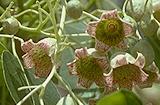 
As you can see, the flowers are bell-shaped about 15mm long, cream on the outside and with reddish/brown blotches inside. I understand that flowering is generally spring and early summer.
Select the thumbnail image or plant name for higher resolution images (33k). Photo: Keith Townsend

[Front Page] [Features] [Departments] [Society Home] [Subscribe]
Australian Plants online - December 2000
Association of Societies for Growing Australian Plants
|